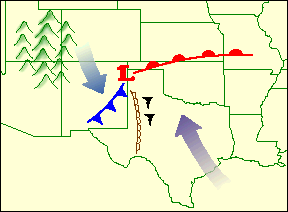

The wind tunnel is the most dangerous thing about the tornado because it could
just scare u to death and another thing about this is that it is mad dangerous . another
thing about the wind there is 6 diffenrt types of dangerous tornadoes by the f0 to f6.
The prevelance of tornadoes increases in some areas of the country more than in others.
Tornadoes in the United States occur
most frequently in ten states. Otherwise known as Tornado Alley, the states involved are
Alabama, Arkansas, Florida, Iowa,
Kansas, Mississippi, Missouri, Nebraska, Oklahoma and Texas. In the southern states the
peak time for tornadoes occurs
between March and May, and again in November. In the northern states the number of
tornadoes peak during April and June.
Common to all of these ten states is their location. They all lie to the east of a line
which runs from Nebraska to Texas, marking
the boundary of the Great Plains. Weather systems develop over the Great Plains resulting
in severe weather patterns. The
topography of these states is such that masses of warm moist air, termed tropical maritime
air, sweep up from the Gulf of
Mexico and the Caribbean Sea due to a lack of mountain barriers. During the spring months,
the earth begins to warm, which
adds to the layer of warm moist air which is close to the ground. While this is occurring
over the Central Plains, cool dry air
masses, termed maritime polar, often sweep in from the north or northeast. This cool air
is trapped in by the Rocky Mountains
and rides close to 10,000 feet above the warmer air below. The jet stream, coming from the
west, acts to mix the already
unstable air within the turbulent atmosphere.
According to Lutgens and Tarbuck, authors of "The Atmosphere," there
are 770 tornadoes reported per year in the United States. Although
tornadoes occur during every month of the year, the months of greates
activity in the United States occur between April and June. The month

between December and January are reported to have the least tornadic
activity. "Typically, 54% of all tornadoes take place during the spring. Fall
and winter, on the other hand, together account for only 19%" (Lutgens,
Tarbuck).
The average tornado travels at around 45 kilometers per hour, follows a
path of about 26 kilometers long, and has a diameter of between 150 and
600 meters. Most tornadoes move toward the northeast, within the zone of southwest winds,
and form ahead of a cold front,
which is associated with the narrow, vertically developed clouds tornadoes form in.